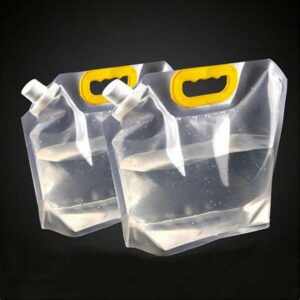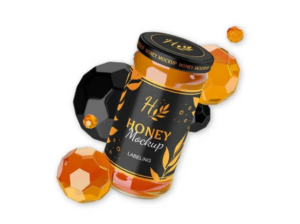Liquids and beverages are notoriously tricky to package. These products require packaging that can be successfully filled, stored, transported, displayed, purchased, used, and disposed of, all while retaining the product’s quality.
Liquid items are primarily packaged in bottles, pouches, and containers. These are prepared using paper, glass, plastic resins, or plastic films.
Liquid packaging with films is accompanied by liquid pouches. Plastic films are molded into various shapes for making pouches. The most widely used plastic films for liquid packaging are:
- BOPP films
- Aluminum
- BOPET films
Let’s explore some important aspects of liquid pouches.

Liquid Packaging Solutions
Types of Liquids Pouches
Liquid pouches offer a lower cost than traditional rigid plastic liquid containers and are friendly to the environment. Many types of liquid pouches are used for securing liquid goods. The essential types of liquid pouches are as follow:
1. Stand-Up Liquid Pouches
Stand-up pouches are a popular method for holding liquid contents due to their flexibility, ease of use, and ability to keep substances fresh. These pouches can accommodate products such as soups, juices, and laundry detergent.
One of the conveniences of stand-up pouches is the ability to place the label on the front or back of the pouch. Resealable labels can also be applied to stand-up pouches to preserve the good’s freshness by resealing the pouch after it has been opened.
Stand-up liquid pouches are made from plastic films such as BOPP, Nylon, Aluminium, and BOPET. BOPET film is mainly employed for making stand-up liquid pouches.

Stand-up Liquid Pouches
2. Stand-Up Liquid Pouches with Spout
This pouch is the latest innovation in the continuing evolution and development of stand-up pouches and packaging technology with the integration of closures into the flexible package.
It features a reclosable spout that is hermetically sealed to the packaging material. This spout protects the product through its lifecycle and can be used for both liquids and powders. These flexible pouches safely contain liquid products and stand up easily on store shelves for a more effective display.
Best of all, when done correctly, spouted stand-up pouches are one of the lowest-cost options for liquid and beverage packaging. Compare spouted bags (made with BOPET film) to glass and rigid plastic – when it comes to quality and price, there’s no contest. It is mainly used for:
- Hand Sanitizer
- Bone Broth
- Cold Brew Coffee
- Cosmetic Products
- Juice
- Powdered Mixes
- Dry Spices
- Yogurt
- Nut Butter
- Shampoo & Conditioner

BOPET Stand-up Pouch with Spout
Benefits of Spout Liquid Pouches
- High convenience: it is straightforward to access content from a liquid pouch bag with a spout on the go.
- Evacuation: liquid pouch bags with a spout can eject 99.5% of their contents, thus reducing food waste.
- High visibility: liquid pouch bags with a spout can be custom printed to make products stand out on retail shelves.
3. Burst Liquid Pouches
The Burst Pouch is a flexible pouch with a layer of poly-film sealed inside to create chambers. The consumer can cut the bottom of the pouch, place it into the desired container, and squeeze it, forcing the liquid to “burst” through the poly membrane and into the desired container. These pouches are usually one hundred percent clear.
The burst pouch, also known as burst bag, is the most advanced technology available for adhesive packaging solutions for two or three-component premeasured liquid systems. They are used mainly for non-edible packaging liq uids, powders, and industrial products.

Burst Liquid Pouch
4. Center Seal Liquid Pouches
The Center Seal Pouch, also known as Pillow Pouch, T-Seal, or Back Pouch, is a standard packaging method used in several industries due to its low cost, flexibility, light-weighted, customizable, and attractive packaging.
The Center Seal Pouch is made of PET/Al/Poly or PET/Poly materials, where it is then formed in the shape of a pillow with a center seat at the back that extends to the end of the product, where it meets the top and bottom seal. The pouch is usually delivered to customers with an opening to allow the filling of their desired contents.

Center Seal Liquid Pouch
5. Dual Components Liquid Pouches
Dual pouches contain more than one connected pouch separated with a seal. They package multiple industrial powders and liquids needed for specific applications.

Dual Components Liquid Pouch
6. Three-Sided Seal Pouches
These liquid pouches are manufactured of one side of metal foil and the other clear plastic or two metal foil pieces. They are mostly used for packaging household products like spices, pet food, and other edible and non-edible products.
Three-Sided Seal Pouches
Which Materials Are Used for Making Liquid Pouches?
Some most common materials that are used to make liquid pouches include:
- Plastic film is used to guard the liquid against oxidation.
- Polyethene terephthalate (PETE) or BOPET is also commonly used to make liquid pouches due to its resistance to heat, oils, solvents, and acids.
- The aluminum foil protects the liquid in the pouch from ultraviolet rays.
- Polyethene (PE) is widely used in liquid pouches because of its broad range of applications and its resistance to chemicals and moisture.
- BOPP is used to produce liquid pouches; because of its lightweight, malleability, strength, stability, processability, and reusability.
- Synthetic biopolymers such as polyhydroxyalkanoates (PHA) and Bacteria cellulose are used to make biodegradable liquid pouches.
- Poly (vinyl alcohol) (PVA), polylactide (PLA), Polyglycolide (PGA), and Poly (e-caprolactone) (PCL) are some of the non-natural polymers that are also used to make biodegradable liquid pouches.
- Anti-oxidation layers made from different materials, such as plastics and aluminum foils, are also used in making liquid pouches.
Why Choose BOPET Film for Liquid Packaging?
A BOPET film is most widely used in liquid packaging for making liquid pouches. It is highly recommended for packaging liquid due to following reasons:
- BOPET film is highly flexible. It allows flexible packaging of liquid.
- BOPET film is biodegradable, so it is preferred due to its environmental and ecological benefits.
- BOPET film offers enough protection from oxygen, light, air, and other regress to protect the freshness and preserve the beverage.
- This film has higher barrier properties to protect the beverage from contaminants.
- This film ensures the security and usability of the liquid pouches.
- BOPET film is highly puncture resistant and pressure resistant. Liquid pouches made with this film might not burst easily.
- BOPET liquid pouches are BPA-free, phthalate-free, and non-toxic. They are FDA approved for safe food contact.

BOPET Liquid Pouches
Applications of BOPET Liquid Pouches
Liquid pouches are used for the following applications:
Automotive Industry
Liquid pouches made with BOPET film are used in the automotive sector to package cleansers, polishes, solvents, grease, and oils.
Health and Beauty
They are used in the health and beauty sector for packaging hair care products, lotions, cosmetics, and many more.
Nutraceutical
These pouches are used in packaging a wide range of nutritional products such as liquid vitamins and many supplements.
Industrial
Liquid pouches provide packaging solutions for many industrial applications like cleansers and lubricants.
Household
Liquid pouches are used for packaging a wide range of household solutions, such as cleaning products, laundry solutions, and pet care items.
Other household products packaged by liquid pouches include sauces, syrup, energy drinks, nut butter, honey liquid packaging, and lawn and garden liquid packaging.
What Is a Bag-in-Box Liquid Packaging?
Bag-in-box packaging is a modern and highly efficient technology for aseptic filling, transportation, and storage of a wide range of liquid and paste-like food and non-food products. They offer the following benefits:
- Long-term storage and usage of the product
- Excellent preservation of the product after opening the package due to a tap
- Minimal transportation, storage, and stock-keeping costs
- Eco-friendliness and ease of recycling

Bag-in-Box Liquid Packaging
Bag-in-Box is mainly used for packaging of following products:
- Wine
- Tomato paste, ketchup, mayonnaise
- Fruit concentrate
- Vegetable oil
- Yolk and white of the egg
- Dairy products and condensed milk
- Drinking water







